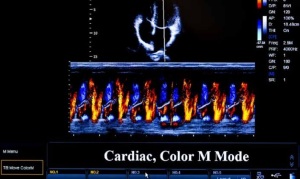by
Sridhar Nadamuni, Contributing Reporter | March 07, 2017
From the March 2017 issue of HealthCare Business News magazine
Heart disease is the leading cause of death in the U.S. Evaluation of the cardiovascular system using ultrasound (US) waves is noninvasive, and facilitates clinical assessment, diagnosis and management of abnormal valves, atrial fibrillation, heart disease and heart murmurs. Studies suggest that nearly 34 million echocardiography procedures were performed on Medicare beneficiaries in the U.S. between 2007 and 2011. Annually, almost 20 percent of enrollees in the fee-for-service (FFS) system receive at least one cardiac echocardiogram. Research suggests that the U.S. imaging equipment market is projected to top $2 billion by 2020, with cardiology and radiology ultrasound equipment sales accounting for 50 percent of the total.
Point-of-care ultrasound device sales are slated for significant growth in the future, driven by new, radiation-free needle placement procedures. “We have seen tremendous development in technologies such as 3-D and strain imaging that are now more mainstreamed, easier to apply, not just for research, but also in routine clinical work, and their use has been validated in the literature,” says Smadar Kort, M.D., FACC, FASE, FAHA, professor of medicine and director of echocardiography at Stony Brook University in New York. “The volume of echocardiograms performed at Stony Brook has definitely increased over the last 10 years, and continues to increase, reflecting the trends elsewhere in the U.S.”
Echocardiography is considered by physicians such as Dr. Kort as the safest, cheapest and quickest noninvasive imaging modality available. It facilitates diagnosis at the bedside, the ICU and the ED. The growth in utilization of echo has been driven by the development of new interventions in both the cath lab as well as the electrophysiology (EP) lab, which rely heavily on echo to identify the appropriate candidates for these procedures, as well as to guide those procedures in real time, says Dr. Kort.




Ad Statistics
Times Displayed: 26180
Times Visited: 582 Stay up to date with the latest training to fix, troubleshoot, and maintain your critical care devices. GE HealthCare offers multiple training formats to empower teams and expand knowledge, saving you time and money
“The requirements for preauthorization, reduced reimbursement for the more expensive, advanced imaging studies, coupled with advances in echo have shifted the utilization more towards echocardiography,” says Dr. Kort, who is also the director, Valve Center, and director of noninvasive cardiac imaging at Stony Brook University. “The need to minimize or avoid radiation exposure from diagnostic imaging has made the field attractive to the patient and caregivers alike,” says Sharon Mulvagh, M.D., FRCP(C), FACC, FAHA, FASE, emeritus professor at the Mayo Clinic in Rochester, Minn., and professor of cardiology at the Dalhousie University Department of Medicine at the Nova Scotia Health Authority in Canada.

